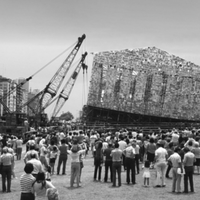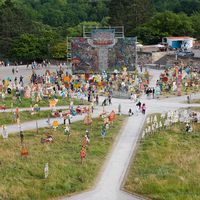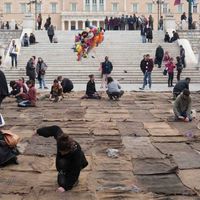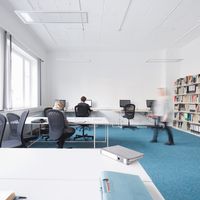A walk through dOCUMENTA (13)
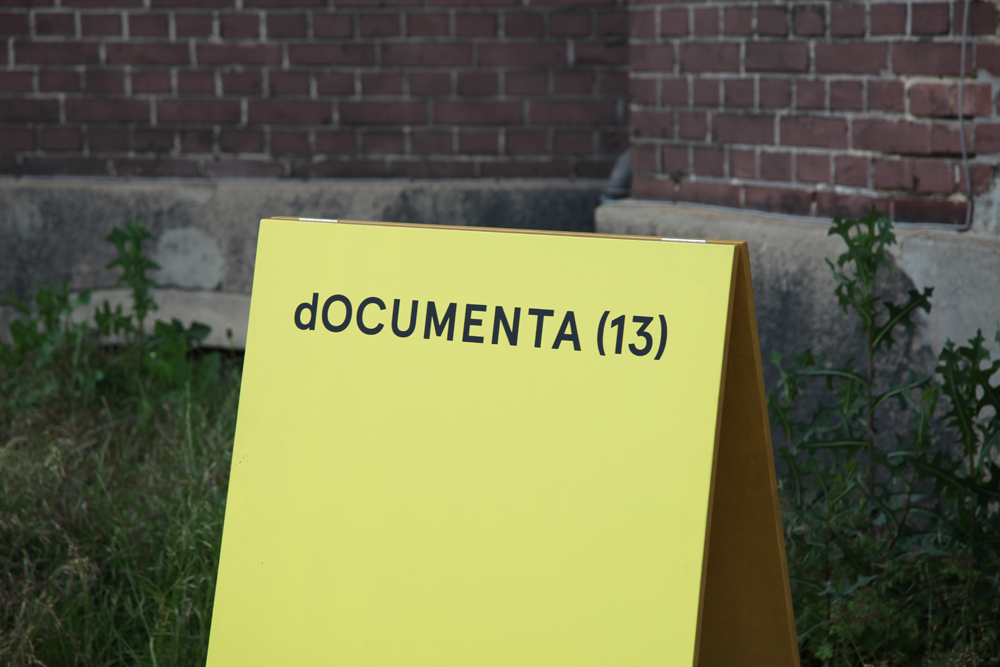
Contributed by Hugh Davies
Films, tours, poetry readings, performances, texts, a huge park of installations, and countless halls of objects representing the work of over 200 arts practitioners make up the 2012 Documenta. Held every five years in Kassel Germany, this year’s monumental collection of dispatches from the world of art has been curated together by Carolyn Christov-Bakargiev under the loose theme of “Objects”. The impossibility of consolidating all the ideas beneath any single heading renders the curators offered theme as good an attempt as any. Activism and antagonism always play a pivotal role in the Documenta exhibitions and this year is no different. The international impact of conflict, commerce and so called progress feature regularly in the works, as do attempts to find meaning and redemption from such global impositions. Fittingly there is an Occupy movement cell pegged on the grass of Friederichsplatz, the camps general message, aesthetic and rhetoric not entirely out of sync with much of Documenta’s 58 year oeuvre as well as resonating with several offerings in the exhibition spaces nearby.
That said, there is simply no way to make any collective account of this mass exhibition of creative experiments and practice based research all other than to reel off some favourites.
Revealing my personal bias for obsessively crafted work, a major highlight was Istvan Csakany’s work, Ghost Keeping. This clothing sweat shop sculpturally reconstructed in blonde timber presents the intricate details of machinery used in the mass production of apparel. From the individual customisations of the sewing machine workstations to the dangerously exposed three phase power outlets, the fastidiously attentive crafting of the sweat shop holds the audience's attention long enough to wonder beyond the works appearance and the workload of its construction, and on to the lives and labour conditions of the workers who inhabit these battery-hen like environments, constructing the clothing we all wear.
A similar penchant for making is found in Geoffrey Farmer’s Leaves Of Grass, a kind of three dimensional collage of seemingly every life magazine photograph from 1935 to 1985. Presented in the majestic and clinically white hall of the Neue Museum, I found traversing the elongated row of images produced a sensation of flicking through 20th century history via the Life magazines in an opulent dentist waiting room.
The sound-scapes of duo Janet Cardiff and George Burns Miller and the cinema-scapes of William Kentridge respectively, appear to have become perennial favourites at large scale art events such as this, and given the capacity these artists have to powerfully transform locations with their poetic installations, rightly so. But sadly, a great many of the works in the central exhibition halls of Documenta left me feeling empty. Some relief was found exploring the collection of works littered around the expansive parklands of Karsrue.
Here, interspersed by garden walks that provide welcome contemplation, are a diverse selection of sculptures, installations and project buildings.
A small temporary building set amongst trees houses Dihn Q Le’s collection of watercolors and drawings created by Vietcong artists, depicting everyday moments of existence of during the years of war. These beautiful and melancholic life drawings of young men and women engaged in the day to day activities of exercising bathing, eating, washing and relaxing stand in stark contrast to any depiction of people during wartime I have ever witnessed.
Signing in as a patient to Pedro Reyes’ Sanatorium, situated nearby, provides short treatments that blend psychology and participative art. Openly offered as placebos and pretence, you sign a document acknowledging that neither the hospital nor the therapists are genuine. But with the fiction of the work disclosed and disclaimed, you are also reminded that through the magic of cognitive dissonance and belief, its falsity does not necessarily render it ineffective. The whole experience is made fun by the young interns dispensing the playful quackery in hospital gowns.
Natascha Sadr Haghighian’s steep slippery Trail through a wooded area fitted with speakers playing voice recordings of animal sounds as pronounced in different human languages takes you out of Karlsaue Park, returning you to the main drag.
The German summer can get surprisingly humid and relief from the almost tropical afternoon heat came in the city’s bunkers, locations also enlisted as exhibition spaces. Found in the cooler conditions of the WW2 refuge is a curious video by Jennifer Allora and Guillermo Calzadilla titled Raptors Rapture, concerning the earliest musical instrument ever found; a 35000 year old flute constructed from the bone of a griffin vulture. The film celebrates its own conceptually robust failure, presenting a flautist specialising in prehistoric instruments attempting to play the ancient bone flute to an expert audience of whom else but a live griffin vulture. After a series of prolonged, noisy and face reddening attempts, the instrumentalist eventually manages to extract three or four barely audible notes; meanwhile the bird looks away with sustained disinterest.
From the bunker, it’s a short walk down Frankenfurter Strasse to a collection of small galleries that are off the Documenta grid but still worthy of a visit. The explosion of audiences attending Documenta is a coup for the local ecosystem of artists operating in Kassel and these committed practitioners have risen to the opportunity providing a free map marking out artist run initiatives and galleries, as well as recommending cheap eats, alternative accommodation and night life insights. Via this local network, an invitation to an exhibition opening or party is often just a friendly chat away.
With only three days in Kassel, there is far too much to take in. I’m not sure a week would suffice. A catalogue can be purchased to assist the digestion, albeit one that is as unwieldy as the exhibition itself. This three volume set is comprised of a phonebook sized tomb containing a complete list of works, a log book of the curators notes documenting the continuous formulation and reformulation of ideas, manifestations, complete with photographs, sketches and discussions with artists, writers, and thinkers, and finally a largish sized but impressively light guide book providing maps for direction and back ground on the artists and their work. Everything is in English and German.
The overwhelming quantity of objects, texts, images and installations ingested in a short period of time has the effect of making them all bleed into each other, lines and links are drawn between potentially unrelated issues, countries, artists, politics, mediums and ideas. Or perhaps this is the intention of the curator who suggests that the works should be experienced not as conceptually synced but rather as in conversation. If that is true, the dominant impression of the conversation overheard is of a globally networked society and culture questioning its own sanity and curiously folding in on itself.
Images courtesy of Charmaine Robbins.
Hugh Davies is a creative artist working in the field of spatial practice. Hugh’s work engages audiences and passers to contribute their own thoughts and ideas, thereby allowing his work to socially evolve.
Similar content
posted on
21 Oct 2016
from - to
18 Jun 2022 - 25 Sep 2022
from - to
17 Jul 2015 - 19 Jul 2015
from - to
08 Apr 2017 - 16 Jul 2017
deadline
07 Sep 2020

